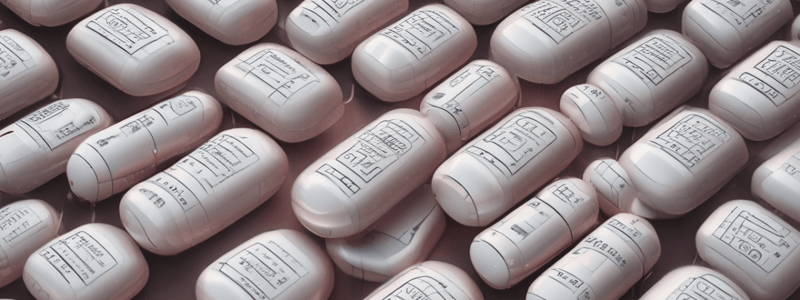Podcast
Questions and Answers
What is the primary purpose of capsules?
What is the primary purpose of capsules?
- To provide a modified release of medicinal substances
- To increase the shelf life of medicinal substances
- To increase the bioavailability of medicinal substances
- To mask the taste of medicinal substances (correct)
What is a characteristic of hard capsules?
What is a characteristic of hard capsules?
- They are more expensive than soft capsules
- They are used for modified release of medicinal substances
- They are cylindrical in shape (correct)
- They are composed of one piece
What is an advantage of hard capsules?
What is an advantage of hard capsules?
- They are easier to formulate than tablets (correct)
- They are cheaper to produce than tablets
- They are more suitable for materials with high moisture content
- They have a slower production rate than tablets
What is a disadvantage of hard capsules?
What is a disadvantage of hard capsules?
What is a potential advantage of hard capsules over tablets?
What is a potential advantage of hard capsules over tablets?
What is a characteristic of soft capsules?
What is a characteristic of soft capsules?
Why are some hard capsules unsuitable?
Why are some hard capsules unsuitable?
What is a potential use of hard capsules?
What is a potential use of hard capsules?
What are the two types of capsules?
What are the two types of capsules?
What is the main advantage of capsular formulations over tablets in terms of bioavailability?
What is the main advantage of capsular formulations over tablets in terms of bioavailability?
What is a unique feature of capsules that allows for the separation of incompatible materials?
What is a unique feature of capsules that allows for the separation of incompatible materials?
What is a limitation of using hard capsules for certain materials?
What is a limitation of using hard capsules for certain materials?
What is an advantage of hard capsules in terms of processing and filling?
What is an advantage of hard capsules in terms of processing and filling?
What is the shape of most hard capsules?
What is the shape of most hard capsules?
What is a potential application of hard capsules?
What is a potential application of hard capsules?
What is a drawback of using hard capsules compared to tablets?
What is a drawback of using hard capsules compared to tablets?
Flashcards are hidden until you start studying
Study Notes
Capsule Technology
Definition and Overview
- Capsules are solid preparations with hard or soft shells of various shapes and capacities, containing a single dose of active substances.
- One capsule can contain one or more active ingredients.
History
- Capsules were invented in the 19th century to mask the taste of medicinal substances.
Types of Capsules
- There are two types of capsules: hard and soft.
- Most hard and soft capsules are orally delivered.
Hard Capsules
Composition and Structure
- Cylindrical shaped, consisting of two pieces: a shorter cap and a longer body.
- The cap goes over the body to contain the contents.
Advantages
- Convenient to carry and have an elegant appearance.
- Reasonably stable and tasteless, making them easy to swallow.
- Easier to formulate than tablets, with lower stress in processing and filling.
- Capsule shell is soluble in physiological fluids at body temperature.
- Potential for higher bioavailability than tablets due to non-compression of powders.
- Readily identifiable, with the possibility of using two colors.
- Can be used to separate incompatible materials and for modified release, and for solid or semi-solid contents.
Disadvantages
- Expensive, with a higher cost than tablets.
- Slower production rate than tablets, with an output rate of around 20% of that of tablets.
- Unsuitable for materials containing high levels of 'free' moisture or that are hygroscopic.
Soft Capsules
- Also known as soft gelatin capsules, soft gels, or one-piece capsules.
Capsule Technology
Definition and Overview
- Capsules are solid preparations with hard or soft shells of various shapes and capacities, containing a single dose of active substances.
- One capsule can contain one or more active ingredients.
History
- Capsules were invented in the 19th century to mask the taste of medicinal substances.
Types of Capsules
- There are two types of capsules: hard and soft.
- Most hard and soft capsules are orally delivered.
Hard Capsules
Composition and Structure
- Cylindrical shaped, consisting of two pieces: a shorter cap and a longer body.
- The cap goes over the body to contain the contents.
Advantages
- Convenient to carry and have an elegant appearance.
- Reasonably stable and tasteless, making them easy to swallow.
- Easier to formulate than tablets, with lower stress in processing and filling.
- Capsule shell is soluble in physiological fluids at body temperature.
- Potential for higher bioavailability than tablets due to non-compression of powders.
- Readily identifiable, with the possibility of using two colors.
- Can be used to separate incompatible materials and for modified release, and for solid or semi-solid contents.
Disadvantages
- Expensive, with a higher cost than tablets.
- Slower production rate than tablets, with an output rate of around 20% of that of tablets.
- Unsuitable for materials containing high levels of 'free' moisture or that are hygroscopic.
Soft Capsules
- Also known as soft gelatin capsules, soft gels, or one-piece capsules.
Studying That Suits You
Use AI to generate personalized quizzes and flashcards to suit your learning preferences.



